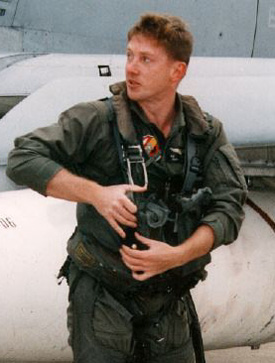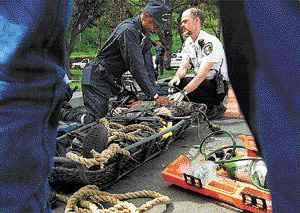Pilot's death
prompts inquiries
Serious mishaps trigger two separate investigations, one amid much secrecy

|
The story so far: Kevin Thompson, the captain of a fishing vessel called One Hope 150, was a quarter mile from where an A-6E jet carrying Lt. Cmdr. Randall E. McNally II and Lt. Cmdr. Brian R. McMahon plunged into the San Francisco Bay on April 5, 1994. Thompson, who was fishing with five 10-year-old boys and a friend at the time, advised his friend to "keep the young boys out of the way and not to let them look at the body in the water." Said Thompson: I knew it was going to be traumatic." |
 MCNALLY FAMILY PHOTO
BECAUSE SOME KEY evidence was not recovered, the exact cause of the crash that killed McNally will never be known, the accident report said
MCNALLY FAMILY PHOTO
BECAUSE SOME KEY evidence was not recovered, the exact cause of the crash that killed McNally will never be known, the accident report said
|
Dayton Daily News The airman Kevin Thompson pulled from San Francisco Bay on April 5, 1994, was the pilot of the A-6E Intruder, Lt. Cmdr. Randall E. McNally.
McNally seemed to be struggling to stay alive as Thompson pulled him into his boat, One Hope 150, and motored to a dock, where a paramedic tried CPR. It was too late. Both McNally and his bombardier-navigator, Lt. Cmdr. Brian R. McMahon, were dead.
The crash that killed McNally and McMahon, married and a father of two, at three minutes before noon was almost instantly labelled a Class A mishap.Class A mishaps involve a death or permanent total disability, at least $1 million in damage or the loss of an aircraft, regardless of the cost. These cases usually trigger two separate investigations.
One investigation is conducted by a team of military personnel working through the service's safety center. Much of this investigation is conducted in secret. Its findings, recommendations and conclusions are not available to the public, although purely factual information can be released.
The military argues that secrecy is the only way to determine the truth and prevent other accidents. Federal courts have upheld the military's argument.
The second investigation triggered by Class A accidents is the so called "legal investigation," called the JAG (Judge Advocate General) manual investigation by the military.
Because the recommendations and conclusions of the safety investigation are secret, it is the legal investigation that is given to the public and to the relatives of dead fliers as the official explanation of what happened. The legal investigation also is what the military offers to civilian courts in the event that someone files a civil lawsuit over a military crash.
But a Dayton Daily News examination found that the explanation the military gives to the public, to grieving relatives and to the courts is not nearly as thorough as the recommendations and conclusions that come from the secret safety investigation -- information the military keeps to itself.
 MICHAEL MACOR/SAN FRANCISCO CHRONICLE
MEDICAL PERSONNEL ADMINISTER first aid and CPR to Lt. Cmdr. Randall E. McNally II after he was pulled from the San Francisco Bay on April 5, 1994. McNally died from his injuries.
MICHAEL MACOR/SAN FRANCISCO CHRONICLE
MEDICAL PERSONNEL ADMINISTER first aid and CPR to Lt. Cmdr. Randall E. McNally II after he was pulled from the San Francisco Bay on April 5, 1994. McNally died from his injuries. |
The officer appointed to investigate the April 5, 1994, crash that killed McNally was Lt. Cmdr. Aladar Nesser, a member of McNally's squadron, who described himself as a "very good friend" of McNally's.
Nesser, now stationed in Italy, said he saw no conflict of interest in investigating his friend's accident.
"Why would it be?" he asked. "We're professionals. It's a professional (organization) you're talking about: military aviation.
"It's not uncommon for people to know each other and be friends."
Nesser, an experienced A-6 pilot, said he had no specialized training in conducting aviation investigations except for a course on writing JAG manual reports he took as part of a three-to-four-month officer school he attended in 1980. He wasn't sure how long the course on JAG reports lasted.
"I don't remember. It was 20 years ago," he said.
Nesser said he had conducted one other JAG manual investigation, into a motorcycle accident.
The plane was scheduled to be decommissioned, but Nesser said that had nothing to do with the accident.
"There were key upgrades on this (type of) airplane even knowing it was going to be decommissioned," he said.
Under item 14 in the "Opinions" section of Nesser's accident report, he wrote that the crew was too experienced and the angle of the plane too steep to blame the crash only on pilot error.
"Considering the high experience level and professionalism of the flight crew and obvious severity of such a gross overbank, an undetermined material failure . . . cannot be ruled out," he wrote.
Because less than half of the wreckage was recovered and because key evidence was among the wreckage not recovered, the exact cause will never be known, he said.
"Significant parts which would have aided in determining the cause of the mishap were never found," his accident report says.
During an interview, Nesser said, "It's one of three things: pilot error, mechanical failure or a little of each.
"My guess is it's a little of each."
Main Story:
Contractors protected from suits |